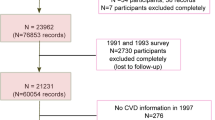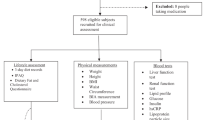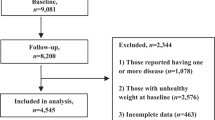Abstract
Background/Objectives:
Biomarkers for a mixed fruit and vegetable (FV) diet are needed to provide a better understanding of the association between FV intake and type 2 diabetes. We aimed to examine the prospective association between a composite score comprised of three biomarkers of FV intake in free-living populations and incident diabetes.
Subjects/Methods:
A total of 318 incident diabetes cases and 926 controls from the EPIC (European Prospective Investigation of Cancer)-Norfolk study aged 40–79 years at baseline (1993–1997), completed 7-day prospective food diary and had plasma vitamin C and carotenoid measures. A composite biomarker score (CB-score) comprising the sum of plasma vitamin C, beta-carotene and lutein was derived. Odds ratios (ORs) and 95% confidence intervals (CIs) for incident diabetes were estimated using multivariable logistic regression.
Results:
A strong inverse association was found between the CB-score and incident diabetes. The ORs (95% CI) of diabetes comparing quartiles Q2, Q3 and Q4 of the CB-score with Q1 (reference category) were 0.70 (0.49, 1.00), 0.34 (0.23, 0.52) and 0.19 (0.12, 0.32), respectively, and 0.49 (0.40, 0.58) per s.d. change in CB-score in a model adjusted for demographic and lifestyle factors. The association was marginally attenuated after additionally adjusting for body mass index and waist circumference (0.60 (0.49 and 0.74) per s.d. change in CB-score).
Conclusions:
A combination of biomarkers representing the intake of a mixed FV diet was strongly inversely associated with incident diabetes. These findings provide further support for measuring dietary biomarkers in studies of diet-disease associations and highlight the importance of consuming FV for the prevention of diabetes.
This is a preview of subscription content, access via your institution
Access options
Subscribe to this journal
Receive 12 print issues and online access
$259.00 per year
only $21.58 per issue
Buy this article
- Purchase on Springer Link
- Instant access to full article PDF
Prices may be subject to local taxes which are calculated during checkout

Similar content being viewed by others
References
WHO/FAO Diet, nutrition and the prevention of chronic diseases: report of a joint FAO/WHO Expert Consultation. World Health Organization: Geneva, USA, 2003, . WHO Technical Report Series no. 916.
Bazzano LA, Li TY, Joshipura KJ, Hu FB . Intake of fruit, vegetables, and fruit juices and risk of diabetes in women. Diabetes Care 2008; 31: 1311–1317.
Ford ES, Mokdad AH . Fruit and vegetable consumption and diabetes mellitus incidence among U.S. adults. Prev Med 2001; 32: 33–39.
Harding AH, Wareham NJ, Bingham SA, Khaw K, Luben R, Welch A et al. Plasma vitamin C level, fruit and vegetable consumption, and the risk of new-onset type 2 diabetes mellitus: the European prospective investigation of cancer—Norfolk prospective study. Arch Intern Med 2008; 168: 1493–1499.
Liu S, Serdula M, Janket SJ, Cook NR, Sesso HD, Willett WC et al. A prospective study of fruit and vegetable intake and the risk of type 2 diabetes in women. Diabetes Care 2004; 27: 2993–2996.
Meyer KA, Kushi LH, Jacobs DR Jr., Slavin J, Sellers TA, Folsom AR . Carbohydrates, dietary fiber, and incident type 2 diabetes in older women. Am J Clin Nutr 2000; 71: 921–930.
Hamer M, Chida Y . Intake of fruit, vegetables, and antioxidants and risk of type 2 diabetes: systematic review and meta-analysis. J Hypertens 2007; 25: 2361–2369.
Carter P, Gray LJ, Troughton J, Khunti K, Davies MJ . Fruit and vegetable intake and incidence of type 2 diabetes mellitus: systematic review and meta-analysis. BMJ 2010; 341: c4229.
Hebert JR, Clemow L, Pbert L, Ockene IS, Ockene JK . Social desirability bias in dietary self-report may compromise the validity of dietary intake measures. Int J Epidemiol 1995; 24: 389–398.
Miller TM, Abdel-Maksoud MF, Crane LA, Marcus AC, Byers TE . Effects of social approval bias on self-reported fruit and vegetable consumption: a randomized controlled trial. Nutr J 2008; 7: 18.
Al-Delaimy WK, Ferrari P, Slimani N, Pala V, Johansson I, Nilsson S et al. Plasma carotenoids as biomarkers of intake of fruits and vegetables: individual-level correlations in the European Prospective Investigation into Cancer and Nutrition (EPIC). Eur J Clin Nutr 2005; 59: 1387–1396.
Block G, Norkus E, Hudes M, Mandel S, Helzlsouer K . Which plasma antioxidants are most related to fruit and vegetable consumption? Am J Epidemiol 2001; 154: 1113–1118.
Baldrick FR, Woodside JV, Elborn JS, Young IS, McKinley MC . Biomarkers of fruit and vegetable intake in human intervention studies: a systematic review. Crit Rev Food Sci Nutr 2011; 51: 795–815.
Campbell DR, Gross MD, Martini MC, Grandits GA, Slavin JL, Potter JD . Plasma carotenoids as biomarkers of vegetable and fruit intake. Cancer Epidemiol Biomarkers Prev 1994; 3: 493–500.
Padayatty SJ, Levine M . Fruit and vegetables: think variety, go ahead, eat!. Am J Clin Nutr 2008; 87: 5–7.
van Kappel AL, Steghens JP, Zeleniuch-Jacquotte A, Chajes V, Toniolo P, Riboli E . Serum carotenoids as biomarkers of fruit and vegetable consumption in the New York Women's Health Study. Public Health Nutr 2001; 4: 829–835.
Day N, Oakes S, Luben R, Khaw KT, Bingham S, Welch A et al. EPIC-Norfolk: study design and characteristics of the cohort. European Prospective Investigation of Cancer. Br J Cancer 1999; 80: 95–103.
Bingham SA, Welch AA, McTaggart A, Mulligan AA, Runswick SA, Luben R et al. Nutritional methods in the European Prospective Investigation of Cancer in Norfolk. Public Health Nutr 2001; 4: 847–858.
Cooper AJ, Sharp SJ, Lentjes MA, Luben RN, Khaw KT, Wareham NJ et al. A prospective study of the association between quantity and variety of fruit and vegetable intake and incident type 2 diabetes. Diabetes Care 2012; 35: 1293–1300.
Steghens JP, van Kappel AL, Riboli E, Collombel C . Simultaneous measurement of seven carotenoids, retinol and alpha-tocopherol in serum by high-performance liquid chromatography. J Chromatogr B Biomed Sci Appl 1997; 694: 71–81.
Jenab M, Riboli E, Ferrari P, Friesen M, Sabate J, Norat T et al. Plasma and dietary carotenoid, retinol and tocopherol levels and the risk of gastric adenocarcinomas in the European prospective investigation into cancer and nutrition. Br J Cancer 2006; 95: 406–415.
Wareham NJ, Jakes RW, Rennie KL, Schuit J, Mitchell J, Hennings S et al. Validity and repeatability of a simple index derived from the short physical activity questionnaire used in the European Prospective Investigation into Cancer and Nutrition (EPIC) study. Public Health Nutr 2003; 6: 407–413.
Welch AA, McTaggart A, Mulligan AA, Luben R, Walker N, Khaw KT et al. DINER (Data Into Nutrients for Epidemiological Research)—a new data-entry program for nutritional analysis in the EPIC-Norfolk cohort and the 7-day diary method. Public Health Nutr 2001; 4: 1253–1265.
Bingham SA, Gill C, Welch A, Cassidy A, Runswick SA, Oakes S et al. Validation of dietary assessment methods in the UK arm of EPIC using weighed records, and 24-hour urinary nitrogen and potassium and serum vitamin C and carotenoids as biomarkers. Int J Epidemiol 1997; 26: S137–S151.
Gross M, Yu X, Hannan P, Prouty C, Jacobs DR Jr . Lipid standardization of serum fat-soluble antioxidant concentrations: the YALTA study. Am J Clin Nutr 2003; 77: 458–466.
Buijsse B, Feskens EJ, Schulze MB, Forouhi NG, Wareham NJ, Sharp S et al. Fruit and vegetable intakes and subsequent changes in body weight in European populations: results from the project on Diet, Obesity, and Genes (DiOGenes). Am J Clin Nutr 2009; 90: 202–209.
Ferrucci L, Perry JR, Matteini A, Perola M, Tanaka T, Silander K et al. Common variation in the beta-carotene 15,15'-monooxygenase 1 gene affects circulating levels of carotenoids: a genome-wide association study. Am J Hum Genet 2009; 84: 123–133.
Day NE, Wong MY, Bingham S, Khaw KT, Luben R, Michels KB et al. Correlated measurement error—implications for nutritional epidemiology. Int J Epidemiol 2004; 33: 1373–1381.
Hu FB, Manson JE, Stampfer MJ, Colditz G, Liu S, Solomon CG et al. Diet, lifestyle, and the risk of type 2 diabetes mellitus in women. N Engl J Med 2001; 345: 790–797.
Ford ES, Williamson DF, Liu S . Weight change and diabetes incidence: findings from a national cohort of US adults. Am J Epidemiol 1997; 146: 214–222.
He K, Hu FB, Colditz GA, Manson JE, Willett WC, Liu S . Changes in intake of fruits and vegetables in relation to risk of obesity and weight gain among middle-aged women. Int J Obes Relat Metab Disord 2004; 28: 1569–1574.
Bashan N, Kovsan J, Kachko I, Ovadia H, Rudich A . Positive and negative regulation of insulin signaling by reactive oxygen and nitrogen species. Physiol Rev 2009; 89: 27–71.
Pitocco D, Zaccardi F, Di Stasio E, Romitelli F, Santini SA, Zuppi C et al. Oxidative stress, nitric oxide, and diabetes. Rev Diabet Stud 2010; 7: 15–25.
Kataja-Tuomola M, Sundell JR, Mannisto S, Virtanen MJ, Kontto J, Albanes D et al. Effect of alpha-tocopherol and beta-carotene supplementation on the incidence of type 2 diabetes. Diabetologia 2008; 51: 47–53.
Liu S, Ajani U, Chae C, Hennekens C, Buring JE, Manson JE . Long-term beta-carotene supplementation and risk of type 2 diabetes mellitus: a randomized controlled trial. JAMA 1999; 282: 1073–1075.
Czernichow S, Couthouis A, Bertrais S, Vergnaud AC, Dauchet L, Galan P et al. Antioxidant supplementation does not affect fasting plasma glucose in the Supplementation with Antioxidant Vitamins and Minerals (SU.VI.MAX) study in France: association with dietary intake and plasma concentrations. Am J Clin Nutr 2006; 84: 395–399.
Song Y, Cook NR, Albert CM, Van Denburgh M, Manson JE . Effects of vitamins C and E and beta-carotene on the risk of type 2 diabetes in women at high risk of cardiovascular disease: a randomized controlled trial. Am J Clin Nutr 2009; 90: 429–437.
Montonen J, Knekt P, Jarvinen R, Reunanen A . Dietary antioxidant intake and risk of type 2 diabetes. Diabetes Care 2004; 27: 362–366.
Hozawa A, Jacobs DR Jr., Steffes MW, Gross MD, Steffen LM, Lee DH . Associations of serum carotenoid concentrations with the development of diabetes and with insulin concentration: interaction with smoking: the Coronary Artery Risk Development in Young Adults (CARDIA) Study. Am J Epidemiol 2006; 163: 929–937.
Meyskens FL Jr., Szabo E . Diet and cancer: the disconnect between epidemiology and randomized clinical trials. Cancer Epidemiol Biomarkers Prev 2005; 14: 1366–1369.
Acknowledgements
We thank the EPIC-Norfolk participants and the EPIC-Norfolk team for their contributions. We also thank Amit Bhaniani, Department of Public Health and Primary Care, University of Cambridge, for help with data. The EPIC-Norfolk study is supported by programme grants from the Medical Research Council UK and Cancer Research UK. The sponsors did not participate in the design or conduct of this study; in the collection, management, analysis, or interpretation of data; in the writing of the manuscript; or in the preparation, review, approval, or decision to submit this manuscript for publication. We acknowledge support from the MRC Epidemiology Unit (MC_UU_12015/5).
Author Contributions
AJMC had full access to all the data in the study and takes responsibility for the accuracy of the data analysis. NGF, NJW and K-TK are the guarantors of this work and, as such, had full access to all data in the study, and take responsibility for the integrity of the data and the accuracy of the data analysis. NJW, K-TK and RNL acquired the data. AJMC and NGF conceived and designed the study. AJMC, NGF and SJS analysed and interpreted the data. AJMC drafted the manuscript, and all authors critically revised the manuscript for important intellectual content and have approved the final version.
Author information
Authors and Affiliations
Corresponding author
Ethics declarations
Competing interests
The authors declare no conflict of interest.
Rights and permissions
About this article
Cite this article
Cooper, A., Sharp, S., Luben, R. et al. The association between a biomarker score for fruit and vegetable intake and incident type 2 diabetes: the EPIC-Norfolk study. Eur J Clin Nutr 69, 449–454 (2015). https://doi.org/10.1038/ejcn.2014.246
Received:
Revised:
Accepted:
Published:
Issue Date:
DOI: https://doi.org/10.1038/ejcn.2014.246
This article is cited by
-
How do short-term associations between diet quality and metabolic risk vary with age?
European Journal of Nutrition (2021)
-
Fruit and vegetable intake and cardiovascular risk factors in people with newly diagnosed type 2 diabetes
European Journal of Clinical Nutrition (2017)
-
Metabolomics for Improved Understanding and Prediction of Cardiometabolic Diseases—Recent Findings from Human Studies
Current Nutrition Reports (2015)



